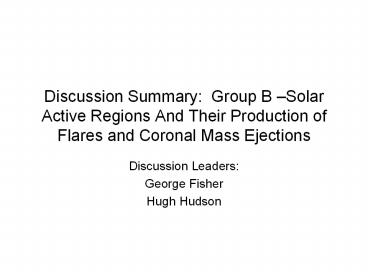Discussion Summary: Group B - PowerPoint PPT Presentation
1 / 10
Title:
Discussion Summary: Group B
Description:
Measurements of coronal magnetic field strength on the solar disk. spectroscopic coronagraph to measure shocks in low corona space-based force-free full-disk vector ... – PowerPoint PPT presentation
Number of Views:59
Avg rating:3.0/5.0
Title: Discussion Summary: Group B
1
Discussion Summary Group B Solar Active
Regions And Their Production of Flares and
Coronal Mass Ejections
- Discussion Leaders
- George Fisher
- Hugh Hudson
2
Our Discussion led to 2 classes of potential
solar hazard prediction tools
- Existing techniques that have obvious usefulness,
but need further development and testing - Strategic tools that will offer much better
solar-weather forecasting, but need a sustained
effort over a long time before the results will
be achieved
3
Promising solar forecast tools that exist now
- Empirical Magnetogram based predictors for CMEs
and Flares in active regions
4
- Helioseismic forecasts of active regions
- before they rotate around the limb
5
... before they emerge, and before the
occurrence of large flares
6
Other existing techniques that appear very
promising and/or easily implemented and tested
- Force-free magnetogram measures of free magnetic
energy - Measuring the flux of magnetic free energy
through the photosphere - Coronal morphology changes 6-24 hours prior to
eruption, e.g. coronal density enhancements
7
Strategic research that will lead to better
prediction of CMEs I
- Force-free (chromosphere or higher) vector
magnetograms - Techniques for assimilating datasets relevant to
the global coronal magnetic field, radio and
X-ray/EUV imaging spectroscopy, and coronal
seismology. - Detailed observational determination of the
magnetic topology in filament channels to
determine the CME eruption mechanism
8
Strategic research that will lead to better
prediction of CMEs II
- Observational investigations of the sequence of
events in filament, CME, and flare dynamics at
flare onset and early development. - Self-consistent MHD models of coupled
photospheric, chromospheric, and coronal parts of
the solar atmosphere to pursue a vigorous
investigation of CME initiation physics and how
to drive such models with real observational
data. - Determine how flares (e.g., magnetic
reconnection) can accelerate particles able to
fill a large open-field domain
9
Resources a Sentinels Component
- A Sentinels program is essential for improved
forecasting of dangerous solar activity on time
scales of days to weeks - The most important Sentinels observation would be
line-of-sight magnetography
10
Other needed resources
- Measurements of coronal magnetic field strength
on the solar disk. - spectroscopic coronagraph to measure shocks in
low corona - space-based force-free full-disk vector
magnetograph































